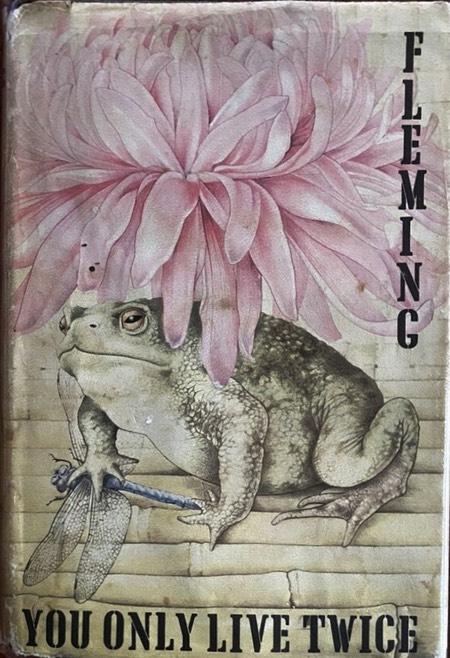Mixing Up the Order
You Only Live Twice and On Her Majesty’s Secret Service came close to being filmed in the appropriate order, if only the weather had cooperated.
Instead, Fleming’s haunting sequel to OHMSS became the capstone to the current run of Bond films starring Sean Connery, a series which had been launched with a thinly-veiled adaptation of Walt Disney’s 20,000 Leagues Under the Sea. Fittingly, the screenplay for the new film was pieced together by Fleming’s friend and former Disney collaborator Roald Dahl, who shared the author’s piquant sense of humor and sense of outlandish adventure.

The book’s Bond, a broken and hollowed-out figure following the death of his wife, is dispatched to Japan to borrow the world’s most advanced code-breaker. With the help of Tiger Tanaka, the head of Japan’s Secret Service, Bond passes along the translated text of an intercepted message which helps avert what might have escalated into thermonuclear war.
Now indebted to Tanaka, Bond is offered a dangerous mission to eliminate a mysterious figure known as Dr. Shatterhand, who presides over a botanical “Disneyland of death,” where young Japanese are lured with the promise of an honorable demise. Realizing that Shatterhand is really his old enemy Ernst Stavro Blofeld, Bond accepts.
While the plot had to be jettisoned, Bond having no motive as yet for seeking personal revenge on Blofeld, the film manages to salvage some of the book’s texture. Bond saving a world on the brink of war, Bond’s fall through an oubliette, a “civilized” bath, Tiger Tanaka, Kissy Suzuki, Dikko Henderson, a faux marriage, Ama diving girls, Blofeld’s volcanic lair, even Bond’s apparent death and his Japanese makeover - are all repurposed from Fleming’s text and molded around a new threat.
It almost seems that Roald Dahl decided to bookend the Bond series to date, with a more extravagant version of the first entry, Dr. No, another film in which a secretive mastermind sabotages the space program. Besides Disney’s 20,000 Leagues, the result also has glimmerings of another Jules Verne title, Master of the World, in which a half-mad genius launches his convertible airship from an extinct volcano.
A more direct influence on Dahl’s script came from a list of detailed suggestions provided by the production team, based on what had worked best in previous films, especially Goldfinger. For instance, while it was almost mandatory to sacrifice one female victim early in the story, it would be better to sacrifice two. Thus, in addition to poisoning Bond’s ally Aki, the YOLT script required Helga Brandt to be fed to a school of Piranha. Neither character appears in Fleming’s novel. Both were conjured up to die for the sake of a formula.
If women still had to be sacrificed, at least they weren’t batted around by the hero this time. Critic Pauline Kael noted that for all of the mayhem in You Only Live Twice, Connery plays a kinder, gentler Bond here, his sexual liasions actually resembling “love relationships.”

Both the book and the film seem to tip a hat to Walt Disney. Where Fleming’s previous novel, On Her Majesty’s Secret Service, traces the origin of Walt’s surname, the sequel compares Blofeld’s volcanic castle to a lethal version of Disney’s Anaheim theme park. Designer Ken Adam’s staggering concept for the climax of the film actually seems to combine the hollowed-out Matterhorn, the park's encircling monorail track, and Tomorrowland’s moon rocket poised on a launch pad, to create a literal realization of Fleming’s whimsical metaphor. It’s the star of the show.
Freed from the constraints of Fleming’s plot, You Only Live Twice was the first Bond film to venture into pure, outrageous, formulaic spectacle. That it made less money than Thunderball, can be chalked up to the glut of secret-agent content in theaters and on television that year. You Only Live Twice wasn’t even the only James Bond film that opened in the spring of 1967.
For all its silly extravagance Casino Royale arrived in theaters first and probably siphoned some of the gas from the second film’s tank..
Still, Sean Connery’s supposed swan song as Bond performed well enough that it would serve as a model for two later entries in the series, The Spy Who Loved Me and Moonraker. Unused elements of the Fleming novel would get a much-belated transfer to the screen in No Time To Die.